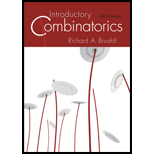
Concept explainers
To count: The number of four-digit numbers whose digits are 1, 2, 3, 4, or 5 and no property holds.
Answer to Problem 1E
The number of four digit numbers is 625.
Explanation of Solution
Procedure used:
Multiplication principle:
When a task has p outcomes and, no matter what the outcome of the first task, a second task has some q outcomes, then the two tasks performed consecutively will have
Calculation:
It is given that the four-digit number has to be formed from amongst the five digits.
As no property holds, each digit place of the four-digit number will be any of the five digits.
Hence, the number of four digit numbers becomes
Therefore, the number of four digit numbers is 625.
To count: The number of four-digit numbers whose digits are 1, 2, 3, 4, or 5 and the property of the digits being distinct, holds.
Answer to Problem 1E
The number of four digit numbers is 120.
Explanation of Solution
Procedure used:
Multiplication principle:
When a task has p outcomes and, no matter what the outcome of the first task, a second task has some q outcomes, then the two tasks performed consecutively will have
Calculation:
It is given that the four-digit number has to be formed from amongst the five digits.
As property of the digit being distinct holds, each digit place of the four-digit number will be any of the five digits but one less from the previous in the next place.
Hence, the number of four digit numbers becomes
Therefore, the number of four digit numbers is 120.
To count: The number of four-digit numbers whose digits are 1, 2, 3, 4, or 5 and the property of the number being even.
Answer to Problem 1E
The number of four digit numbers is 250.
Explanation of Solution
Procedure used:
Multiplication principle:
When a task has p outcomes and, no matter what the outcome of the first task, a second task has some q outcomes, then the two tasks performed consecutively will have
Calculation:
It is given that the four-digit number has to be formed from amongst the five digits.
As the property of the number being even holds, each digit place of the four-digit number will be any of the five digits except at unit’s place.
The unit’s place of the numbers will carry even digits that are 2 and 4.
Hence, the number of four digit numbers becomes
Therefore, the number of four digit numbers is 250.
To count: The number of four-digit numbers whose digits are 1, 2, 3, 4, or 5 and both the properties hold.
Answer to Problem 1E
The number of four digit numbers is 48.
Explanation of Solution
Procedure used:
Multiplication principle:
When a task has p outcomes and, no matter what the outcome of the first task, a second task has some q outcomes, then the two tasks performed consecutively will have
Calculation:
It is given that the four-digit number has to be formed from amongst the five digits.
As both the properties hold, each digit place of the four-digit number will be any of the five digits.
However, the choices for the unit’s place are 2 and the choices for other places starts from 4 and ends at 2.
Hence, the number of four digit numbers becomes
Therefore, the number of four digit numbers is 48.
Want to see more full solutions like this?
Chapter 2 Solutions
Introductory Combinatorics
- Shading a Venn diagram with 3 sets: Unions, intersections, and... The Venn diagram shows sets A, B, C, and the universal set U. Shade (CUA)' n B on the Venn diagram. U Explanation Check A- B Q Search 田arrow_forward3. A different 7-Eleven has a bank of slurpee fountain heads. Their available flavors are as follows: Mountain Dew, Mountain Dew Code Red, Grape, Pepsi and Mountain Dew Livewire. You fill five different cups full with each type of flavor. How many different ways can you arrange the cups in a line if exactly two Mountain Dew flavors are next to each other? 3.2.1arrow_forwardBusinessarrow_forward
- Please explain how come of X2(n).arrow_forwardNo chatgpt pls will upvotearrow_forwardFind all solutions of the polynomial congruence x²+4x+1 = 0 (mod 143). (The solutions of the congruence x² + 4x+1=0 (mod 11) are x = 3,4 (mod 11) and the solutions of the congruence x² +4x+1 = 0 (mod 13) are x = 2,7 (mod 13).)arrow_forward
- https://www.hawkeslearning.com/Statistics/dbs2/datasets.htmlarrow_forwardDetermine whether each function is an injection and determine whether each is a surjection.The notation Z_(n) refers to the set {0,1,2,...,n-1}. For example, Z_(4)={0,1,2,3}. f: Z_(6) -> Z_(6) defined by f(x)=x^(2)+4(mod6). g: Z_(5) -> Z_(5) defined by g(x)=x^(2)-11(mod5). h: Z*Z -> Z defined by h(x,y)=x+2y. j: R-{3} -> R defined by j(x)=(4x)/(x-3).arrow_forwardDetermine whether each function is an injection and determine whether each is a surjection.arrow_forward
 Discrete Mathematics and Its Applications ( 8th I...MathISBN:9781259676512Author:Kenneth H RosenPublisher:McGraw-Hill Education
Discrete Mathematics and Its Applications ( 8th I...MathISBN:9781259676512Author:Kenneth H RosenPublisher:McGraw-Hill Education Mathematics for Elementary Teachers with Activiti...MathISBN:9780134392790Author:Beckmann, SybillaPublisher:PEARSON
Mathematics for Elementary Teachers with Activiti...MathISBN:9780134392790Author:Beckmann, SybillaPublisher:PEARSON
 Thinking Mathematically (7th Edition)MathISBN:9780134683713Author:Robert F. BlitzerPublisher:PEARSON
Thinking Mathematically (7th Edition)MathISBN:9780134683713Author:Robert F. BlitzerPublisher:PEARSON Discrete Mathematics With ApplicationsMathISBN:9781337694193Author:EPP, Susanna S.Publisher:Cengage Learning,
Discrete Mathematics With ApplicationsMathISBN:9781337694193Author:EPP, Susanna S.Publisher:Cengage Learning, Pathways To Math Literacy (looseleaf)MathISBN:9781259985607Author:David Sobecki Professor, Brian A. MercerPublisher:McGraw-Hill Education
Pathways To Math Literacy (looseleaf)MathISBN:9781259985607Author:David Sobecki Professor, Brian A. MercerPublisher:McGraw-Hill Education





